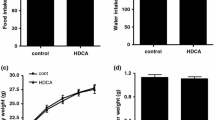Abstract
The mechanism responsible for the hypocholestermic action of arylsulfonate esters of long chain fatty alcohols has been studied with rats fed either normocholesteremic or hypercholesteremic (1% cholesterol plus 0.5% glycocholate) diets. Linoleyl tosylate is more effective in lowering plasma and liver cholesterol levels of rats on the hypercholesteremic diet than several other hypocholesteremic agents tested. Linoleyl tosylate does not redistribute cholesterol to extrahepatic tissues nor inhibit hepatic cholesterol biosynthesis. Linoleyl tosylate is not effective in counteracting Tritoninduced hypercholesteremia nor in lowering plasma cholesterol levels of the suckling rat. Linoleyl tosylate increases the fecal elimination of dietary [4-14C] cholesterol and prevents its accumulation in blood and liver. Oleyl p-(n-decyl) benzene sulfonate also prevents the apparent absorption of [26-14C] cholesterol from the gastrointestinal tract. Linoleyl tosylate increases the fecal excretion of neurtal sterols but not of bile acids. The results indicate that the arylsulfonate esters of long chain fatty alcohols lower body cholesterol levels by inhibiting cholesterol absorption from the gastrointestinal tract. Exactly how absorption is inhibited is not clear, but linoleyl tosylate was found to stimulate the activity of cholesteryl esterase prepared from the intestinal mucosa.
Similar content being viewed by others
References
Quackenbush, F.W., P.G. Rand, and J.E. MacNintch, Lipids, 12:686 (1977).
Quackenbush, F.W., W.M. Grogan, Jr., S. Midland, F.P. Bell, J.E., MacNintch, T.C. Hutsell, G. Cruzan, and H.C. Klauda, Artery, to be submitted.
Sperry, W.M., and M. Webb, J. Biol. Chem. 187:97 (1950).
Harris, R.A., and D. Gambal, Anal. Biochem. 5:479 (1963).
Wilson, J.D., J. Lipid Res. 5:409 (1965).
Thompson, S., J. Gangule, and S. Kon, Br. J. Nutr. 3:50 (1959).
Bloomfield, D.K., Proc. Nat. Acad. Sci. 50:117 (1965).
Moore, R.P., and C.A. Baumann, J. Biol. Chem. 195:615 (1952).
Levin, S.J., J.C. Irvin, and C.G. Johnston, Anal. Chem. 33:856 (1961).
Gambal, D., and F.W. Quackenbush, J. Nutr. 70:497 (1960).
Lossow, W.J., R.H. Migliomi, N. Brot, and I.L. Chaikoff, J. Lipid Res. 5:198 (1964).
Shah, S.N., W.J. Lossow, and I.L. Chaikoff, Ibid. 6:228 (1965).
Paoletti, R., Am. J. Clin. Nutr. 10:277 (1962).
Harris, R.A., “Studies upon Suckling Rat Hypercholesteremia and the Mechanism for Cholesterol Lowering by Sulfonate Esters,” Ph.d. Thesis, Purdue University, Lafayette, IN, 1965.
Best, M.M., and C.H. Duncan, Am. J. Physiol. 19:1000 (1960).
Huff, J.W., and J.L. Gilfillan, Proc. Soc. Exp. Biol. Med. 103:41 (1960).
Thorp, J.M., and W.S. Waring, Nature 194:948 (1962).
Dick, E.C., S.M. Greenberg, J.F. Herndon, M. Jones, and E.J. Van Loon, Proc. Soc. Exp. Biol. Med. 104:523 (1960).
Siperstein, M.D., Curr. Top. Cell Regul. 2:65 (1970).
Goodman, D.S., Physiol. Rev. 45:747 (1965).
Fukushima, H., S. Aono, and H. Nakatani, J. Nutr. 96:15 (1968).
Fukushima, H., K. Toki, and H. Nakatani, J. Atheroscler. Res. 9:57 (1969).
Kritchevsky, D., and S.A. Tepper, Ibid. 7:527 (1967).
Nakatani, H., Jap. J. Pharmacol. 16:391 (1966).
Nakatani, H., S. Aono, Y. Suzuki, H. Fukushima, Y. Nakamura, and K. Toki, Atherosclerosis 12:307 (1970).
Takeuchi, N., and Y. Yamamura, Clin. Pharmacol. Therap. 16:368 (1974).
Fukushima, H., S. Aono, and Y. Nakamura, J. Atheroscler. Res. 10:403 (1969).
Nakatani, H., H. Fukushima, and A. Wakimura, Science 153:1267 (1966).
Kritchevsky, D., and S.A. Tepper, Can. J. Biochem. 46:1429 (1968).
Dvornik, D., Ibid. 46:1430 (1968).
Nagata, A., H. Nakatomi, and K. Toki, Lipids 11:163 (1976).
Author information
Authors and Affiliations
Additional information
Published as Journal Paper No. 6698 Agricultural Experiment Station, Purdue University, Lafayette, IN.
About this article
Cite this article
MacNintch, J.E., Harris, R.A., McLean Grogan, W. et al. Arylsulfonate esters as hypocholesteremic agents: III. Mechanism of action studies. Lipids 12, 819–827 (1977). https://doi.org/10.1007/BF02533271
Received:
Issue Date:
DOI: https://doi.org/10.1007/BF02533271




